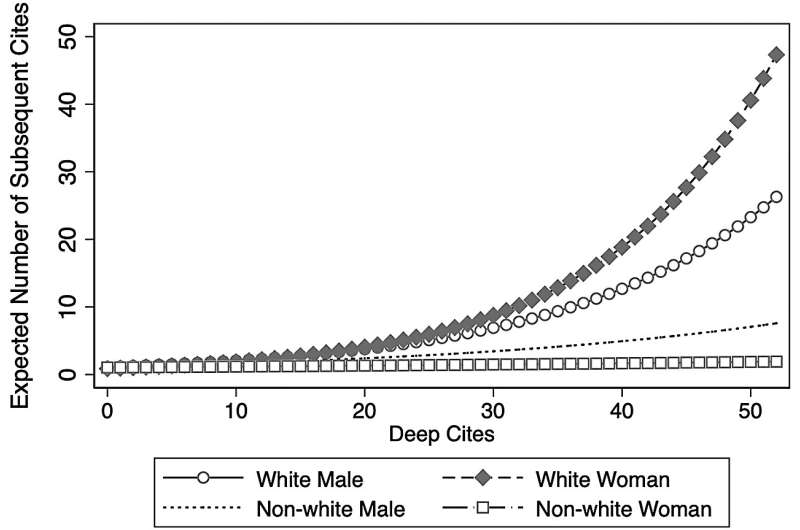This article has been reviewed according to Science X's editorial process and policies. Editors have highlighted the following attributes while ensuring the content's credibility:
fact-checked
peer-reviewed publication
trusted source
proofread
Female judges, especially women of color, cited far less frequently than male judges

The current U.S. Supreme Court may be the newsiest set of judges in the history of the judicial branch. From striking down Roe v. Wade and ending affirmative action, to ruling on President Biden's program to cancel student debt, SCOTUS has not been afraid to make headlines.
The current makeup of the court has also garnered significant attention due to both the political leanings of the justices and their race and gender. With this backdrop, researchers from UNC Charlotte, University of Louisville, University of Georgia and Brigham Young University analyzed how the race and gender of federal judges might be impacting judicial processes. Specifically, they wanted to see which types of judges get the most attention from their peers when they have complete discretion to reference another judge's work.
After analyzing out-of-circuit citations to a sample of more than 2,000 published federal appellate decisions from 2009 to 2016, the researchers found that majority opinions written by female judges receive significantly fewer subsequent citations from other courts than those by men—largely because of disparities in citing Black and Latina women. The findings were published this month in the American Political Science Review.
"We wondered why decisions by some judges are better able to catch the attention of their peers and are afforded more influence in the development of law," said study co-author Robert Christensen, a professor in the Marriott School's Romney Institute of Public Service and Ethics. "Our results indicate a clear bias against citing majority opinions authored by women—especially women of color."
Over the five-year period studied, female judges received 1.4 external citations to their opinions compared to 1.63 citations to opinions written by equivalent male judges. While that difference may initially seem small, it really hits home when accumulated over a career. An average judge produces 53.5 opinions a year, so in 10 years of full-time service, male judges would have 120 more citations than a female judge.
This cumulative difference is particularly problematic because citation of legal precedent is foundational to the U.S. common law legal tradition.
The discrepancy is even more substantial for opinions authored by Latina and Black women, who receive 28% fewer discretionary citations than white males. Over 10 years, this translates to 239 fewer citations for women of color compared to white male judges.
U.S. Supreme Court Justice Sonia Sotomayor observed that "if you are a person of color, you have to work harder than everybody else to succeed."
The researchers, which include lead author John Szmer of UNC Charlotte and co-authors Laura Moyer of University of Louisville and Susan Haire of University of Georgia, found sustained evidence of this in U.S. federal appellate courts, which tend to be the courts of last resort in the federal system. In 2021, the U.S. Circuit of Appeals received 46,165 filings, whereas the U.S. Supreme Court heard 77 cases on the merits.
The authors found that efforts by Black and Latin federal appellate judges to incorporate more extended discussion of legal precedent are much less recognized/cited in subsequent citations by outside circuits than comparable efforts by white judges.
Because algorithms used by legal databases like LexisNexis and Westlaw may exacerbate human biases by promoting opinions that have already been cited in search results, the authors' findings suggest "that stereotypes about social categories, competence and status will play a role in determining whose ideas receive recognition." Given the rise of artificial intelligence, those biased algorithms may become more and more important in the days to come.
"Even among judges who are trained in equity and due process, we are not yet past the point where we can say we live in a bias-free world," Christensen said. "Subconscious biases are still very much at work, and when that is shaping the common law of the country, we think that deserves both scholarly and practical attention."
More information: JOHN SZMER et al, Who Shapes the Law? Gender and Racial Bias in Judicial Citations, American Political Science Review (2023). DOI: 10.1017/S0003055423000801
Journal information: American Political Science Review
Provided by Brigham Young University



















